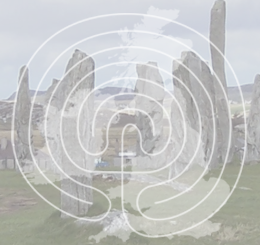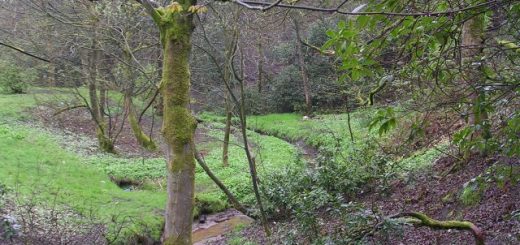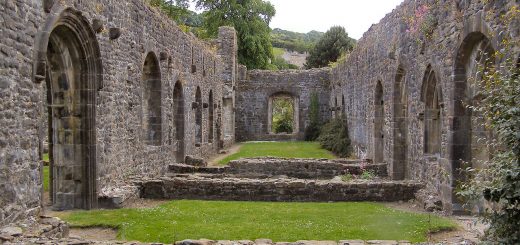The Dun Cow & The Old Rib
In ‘Lancashire Legends’ (1873), John Harland shares the following piece of folklore. ‘The anonymous writer of “Curious Corners round Preston,” states that the “Old Rib ” is the name giyen to an old farm in the township of Whittingham, in the parish of Kirkham, five miles north of Preston. The name, he says, is derived from an extraordinary rib, which was taken from an extraordinary old dun cow; which rib is placed over the door of the farmhouse, as a monument to the excellence of the defunct animal. About a quarter of a mile below the Towneley Arms Inn, in Longridge, about seven miles north-east of Preston, the seeker diverged from the main road into one of those old lanes or pack-horse roads so common in England, a short distance down which lane he came to the house bearing the name of “The Old Rib.” It is a somewhat lofty, square building, with four turrets, like elongated sugar-loaves. The windows are of various forms and sizes, some of elaborate workmanship; and altogether the place has the aspect of having once been a mansion of some importance. On the doorway, at one end of the house, the architect and sculptor appear to have bestowed the greatest labour. The door is of oak, thick and strong, and studded with large square-headed nails ; and there is a ponderous iron ring, serving at once for latch and knocker. Some armorial bearings are seen above, and over these again the “Old Rib,” The doorway has the date of 1615, so that the place was in existence two years before the visit of King James I. to Hoghton Tower. The remains of a moat may be traced around the Old Rib House ; but the moat has been filled up, and the surface is nearly level with its old banks. The few out-buildings standing near are ruins, notwithstanding that they had been built at a much later period, in all probability, than the house itself. As to the tradition of the “Old Dun Cow,” it is related that “once upon a time” there wandered over the elevated and dark moors of Parlick, Bleasdale, Bowland, and Browsholme, a dun cow of stupendous size, and withal of most generous and extraordinary nature; and it is supposed in its daily pasturings to have been in the habit of quenching its thirst at “Nick’s Water-Pot,” — a well on the summit of Parlick. The great merit of this wonderful cow was, that to all comers she gave an abundant supply of milk. Hence her fame spread; and from the heights of Browsholme, the brows of Leagrim, the valley of Chipping — from lofty Bleasdale and lowly Thornley, from haughty Parlick and humble Goosnargh, came milk-seekers in plenty, and none went empty-handed away. No matter how large the pail, it was always filled to the brim. But judging from the size of the rib, the cow must have been of gigantic size — a very Brobdignagian beast! The rib is still about a yard in length, and several inches in thickness; but within the memory of many residing in the district, it was more than twice its present size. Besides the decay consequent on time and exposure to the elements, the rib has suffered greatly from the ruthless hands of relic lovers or despoilers, who have cut and carried off portions of the rib as memorials of the Old Dun Cow. In short, the rib in its pristine proportions must have been “very like a whale,” as Polonius says — at least, a whale’s jaw-bone. Can this have been the origin of the quaint ballad which runs thus? —
“Did you ever, ever, ever, ever, ever, ever, ever, ever, ever, ever, ever, ever, ever see a whale?”
“No I never, never, never, never, never, never, never, never, never, never, never, never, never saw a whale;
But I’ve often, often, often, often, often, often, often, often, often, often, often, often, often seen a cow,
Yes, I’ve often, often, often, often, often, often, often, often, often, often, often, often, often seen a cow.”
To return to the legend of the Old Dun Cow; it may be conjectured that, with such ribs, and giving an ever-flowing, never-failing supply of milk, it must have needed a ladder to milk old Cushy. But alas! “much would have more.” We know how the goose was served that laid golden eggs. It is conjectured that one of the far-famed Pendle witches (perhaps bribed and instigated bysome envious milk-seller who had lost his custom, and wished to destroy the opposition shop) took, instead of a milk-pail, a large riddle or sieve, and went up to milk the old dun cow. At work she kept all day; the milk flowed in rich and copious streams; but at night the riddle was still empty. In vain the bountiful milk-giver taxed her powers to fill the old hag’s strange milk-pail; the effort was too much; the fountain that had never failed before at last became dry; and either through the exhaustion of nature, or from vexation and disappointment at being outwitted by an old woman, the old cow gave up the ghost, and those dreary moors ceased for ever to be “a land flowing with milk.” The rib hangs over the door, a sad memento of the Old Dun Cow, and by its size challenges the attention of the passerby — a sort of “Ex pede Herculem.”




Recent Comments